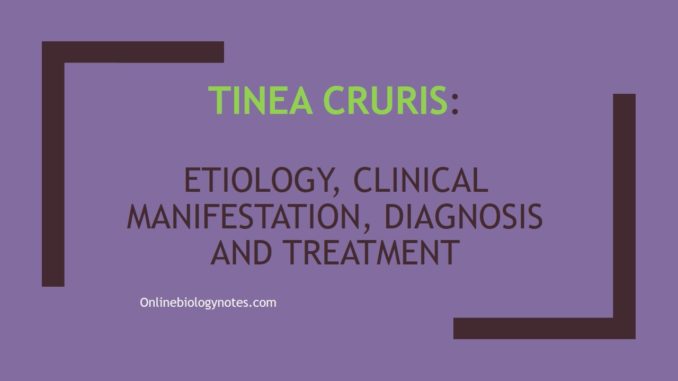
What is Tinea cruris?
- The term tinea cruris refers to the dermatophyte infections of the groin, perianal and pubic region.
- It is commonly known as jock itch and is a form of ringworm.
- It is characterized often by red and itchy rash in warm areas of body and it is prone to people with diabetes and are obese.
- Geographical distribution:
- It is distributed worldwide.
Epidemiology:
- Etiological agent:
- The dermatophytes most often encountered in tinea cruris are the anthropophilic species, Trichophyton rubrum and Epidermophyton fzoccosum less commonly Trichophyton mentagrophytes and Trichophyton verrucosum are involved.
- The development of the infection is favoured by warm moist conditions resulted by maceration and occlusion of the skin in the groin.
- The disease is more prevalent in tropical climates.
- Tinea cruris is mostly seen in men and is seen 3 times more than women.
- The infection often follows spread from another infected site, such as the feet, in the same individual.
- It can also be spread from person to person through direct contact, or through indirect contact via contaminated fomites such as towels, clothing and bed linen.
- Tinea of the groin is a highly contagious condition and outbreaks of infection have sometimes occurred in schools and other closed groups such as sports teams.
Clinical manifestations of tinea cruris:
- Tinea cruris is usually seen as one or more rapidly spreading, erythematous lesions with central clearing on the inside of the thighs.
- The lesions, which tend to coalesce, have a raised erythematous border which encloses a brown area of scaling.
- Patients often complain of intense pruritus.
- Scratching may result in small satellite lesions which sometimes fuse with the primary lesion altering its outline.
- The infection may spread from the inside of the thigh to the scrotum, penis, natal cleft and gluteal folds, as well as to the anterior and posterior aspects of the thighs.
- Localized scrota1 infection is quite common: the clinical signs are often inconspicuous.
Differential diagnosis of Tinea cruris:
- Tinea cruris can be difficult to differentiate from other causes of erythematous groin lesions, such as bacterial and Cundidu intertrigo, erythrasma, psoriasis and sebhorrhoeic dermatitis.
- Women with a crural dermatosis are often infected with Cundidu, whereas men are more likely to have a dermatophyte infection.
- Thus, laboratory tests should be performed in any patient with groin lesions of undetermined origin.
Lab diagnosis
- Microscopy:
- Direct microscopic examination of infected material should reveal the branching hyphae characteristic of a dermatophyte infection.
- Culture:
- Isolation of the aetiological agent in culture will allow the species of fungus involved to be determined.
Treatment of Tinea cruris
- Most patients with tinea cruris will respond to local antifungal treatment within 2-4 weeks.
- Topical imidazoles, such as clotrimazole, econazole, miconazole or sulconazole, and allylamines, such as naftifine or terbinafine, should be applied morning and evening for at least 2 weeks.
- Hygiene measures such as thorough drying and using separate towels for the groin area should prevent spread.
- There is a recurrence in 20–25% of patients.
- If this happens, patients should be given further antifungal treatment and advice about non-pharmacological control measures should be repeated.
- To prevent re-infection, treatment should be continued for at least 1 week after the lesions have cleared.
- Oral treatment should be given if a patient has extensive lesions, or fails to respond to topical treatment, or has tinea pedis as well.
- Itraconazole (100mg/day for 2 weeks) and terbinafine(250mg/dayfor2-4 weeks) have proved more effective than griseofulvin (10mg/kg per day for 2-6 weeks).
Prevention:
- To prevent reinfection following treatment, the patient should be advised to dry the groin thoroughly after bathing and to use separate towels to dry the groin and the rest of the body.
- The feet should be examined and treated if tinea pedis is present.
- Occlusive or synthetic garments should be avoided.
- In case if the patient is obese, weight loss might be of benefit by reducing chafing and sweating.
